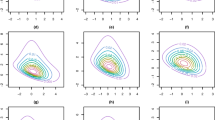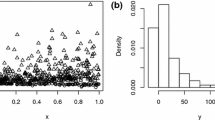Abstract
Normal mixture models are widely used for statistical modeling of data, including classification and cluster analysis. However the popular EM algorithms for normal mixtures may give imprecise estimates due to singularities or degeneracies. To avoid this, we propose a new two-step estimation method: first truncate the whole data set to tail data sets that contain points belonging to one component normal distribution with very high probability, and obtain initial estimates of parameters; then upgrade the estimates to better estimates recursively. The initial estimates are simply Method of Moments Estimates in this paper. Empirical results show that parameter estimates are more accurate than that with traditional EM and SEM algorithms.
Access this chapter
Tax calculation will be finalised at checkout
Purchases are for personal use only
Similar content being viewed by others
References
Dias JG, Wedel M (2004) An empirical comparison of EM, SEM and MCMC performance for problematic Gaussian mixture likelihoods. Stat Comput 14:323–332
Celeux G, Chauveau D, Diebolt J (1995) On stochastic versions of the EM algorithm. Institute National de Recherche en Informatique et en Automatique, Mars, pp 1–22
Karlis D, Xekalaki E (2003) Choosing initial values for the EM algorithm for finite mixtures. Comput Stat Data Anal 41:577–590
Yao W (2013) A note on EM algorithm for mixture models. Stat Probab Lett 83:519–526
Chen LS, Prentice RL, Wang P (2014) A penalized EM algorithm incorporating missing data mechanism for gaussian parameter estimation. Biometrics 70:312–322
Horrace WC (2005) Notes: some results on the multivariate truncated normal distribution. J Multivariate Anal 94:209–221
Horrace WC (2015) Moments of the truncated normal distribution. J Prod Anal 43:133–138
del Castillo J, Daoudi J (2009) The mixture of left–right truncated normal distributions. J Stat Plann Infer 139:3543–3551
Emura T, Konno Y (2014) Erratum to: multivariate normal distribution approaches for dependently truncated data. Stat Papers 55:1233–1236
Author information
Authors and Affiliations
Corresponding authors
Editor information
Editors and Affiliations
Appendix
Appendix
Proof of Theorem 2.1
For convenience, we set \(a=-\infty \). These results also hold true for \(b=\infty \) and \(a<X<b\).
I: Since the variance of normal distribution always exists, by the law of large numbers:
Then
where
Similarly,
Because the following equation is always true:
Suppose \(\hat{\sigma }_{0}^2=\sigma ^2\), let \(g(\mu )=\sigma ^2\frac{f(b|\mu ,\sigma ^2)}{F(b|\mu ,\sigma ^2)}\), then
where \(s=\frac{b-\mu }{\sigma }\), and f(s), F(s) are the density function and cumulative function of the standard normal distribution. Then
By the Lagrange’s mean value theorem we have
where c is between \(\mu \) and \(\hat{\mu }_{t-1}\). So the above Eq. (3) is
Denote \(s_1=\frac{b-c}{\sigma }\). Then \(1-g'(c)>0\) and \(0<F(s_1)(1-g'(c))<1\) are always true. And when \(0.2<F(s_1)<0.8\), \(0<(F(s_1)+0.3)(1-g'(c))<2\).
If \(\mu <\hat{\mu }_{t-1}\), then \(p_{t-1}<F(s_1)<p\), therefor \(0<p_{t-1}(1-g'(c))<F(s_1)(1-g'(c))<1\) is always true. So \(\mu<\hat{\mu }_t<\hat{\mu }_{t-1}\). And then the upgraded estimate sequence converges.
If \(\mu >\hat{\mu }_{t-1}\), then \(\hat{\mu }_t>\hat{\mu }_{t-1}\), and \(p<F(s_1)<p_{t-1}\). When \(p>0.05\), \(0<p_{t-1}(1-g'(c))<1\). Then \(\hat{\mu }_{t-1}<\hat{\mu }_1<\mu \). When \(0.2<p<0.5\), so if \(|p_{t-1}-p|<0.3\), we have \(0<p_{t-1}(1-g'(c))<(F(s_1)+0.3)(1-g'(c))<c\). This implies \(\hat{\mu }_{t-1}<\hat{\mu }_t<\mu +(\mu -\hat{\mu }_{t-1})\).
If \(\hat{\mu }_t>\mu \), that is to say \(\mu<\hat{\mu }_t<\mu +(\mu -\hat{\mu }_{t-1})\), then from the above paragraph the sequence of following upgraded estimate converges. If \(\hat{\mu }_t<\mu \), that is to say \(\hat{\mu }_{t-1}<\hat{\mu }_t<\mu \). Then we could also have the conclusion that the upgraded estimate sequence converges.
So from the above we can conclude that when \(\hat{\sigma }_{0}^2=\sigma ^2\), the upgraded estimate sequence converges. The results hold true for left truncated and both sides truncated normal distributions.
II: Since the variance of normal distribution always exists, by the law of large numbers:
And
where \(s=\frac{b-\mu }{\sigma }\), and f(s), F(s) are the density function and cumulative function of the standard normal distribution.
Similarly:
where \(\hat{s}=\frac{b-\mu }{\hat{\sigma }}\), and \(f(\dot{)}\), \(F(\dot{)}\) are the density function and cumulative function of the standard normal distribution.
Assume \(\hat{\mu }_{0}=\mu \), Let \(g(\sigma ^2)=\sigma ^2\left( 1-\frac{sf(s)}{F(s)} \right) ,\) then
By the Lagrange’s mean value theorem we have
where \(d^2\) is between \(\sigma ^2\) and \(\hat{\sigma }_{t-1}^2\).
And we also have this equation
So
Denote \(s_2=\frac{b-\mu }{d}\). Then from R software \(g'(d)>0\) and \(0<F(s_2)g'(d)<1\) are always true. And when \(0<F(s_2)<0.5\), \(0<(F(s_2)+0.5)g'(d)<1\).
If \(\hat{\sigma }_{t-1}^2<\sigma ^2\), then \(p_{t-1}<F(s_2)<p\), then \(0<p_{t-1}g'(d)<F(s_2)g'(d)<1\) is always true. So \(\hat{\sigma }_{t-1}^2<\hat{\sigma }_t^2<\sigma ^2\) is always true. And then the upgrading process of estimators converges.
If \(\hat{\sigma }_{t-1}^2>\sigma ^2\), then \(\hat{\sigma }_1^2<\hat{\sigma }_{t-1}^2 \), \(p<F(s_2)<p_{t-1}\). As \(|p_{t-1}-p|<0.5\), when \(F(s_2)>0.5\), \(0<p_{t-1}g'(d)<1\), when \(F(s_2)<0.5\), \(0<p_{t-1}g'(d)<(F(s_2)+0.5)g'(d)<1\). That is to say \(\sigma ^2<\hat{\sigma }_1^2<\hat{\sigma }_{t-1}^2\). Then we could also have the conclusion that the upgrading process of estimator converges.
So from the above we can conclude that when \(\hat{\mu }_{t-1}=\mu \), the upgrading process of estimators converges to \(\sigma ^2\).
Rights and permissions
Copyright information
© 2017 Springer International Publishing AG
About this chapter
Cite this chapter
Hu, Q., Wei, Z., Li, B., Wang, T. (2017). New Estimation Method for Mixture of Normal Distributions. In: Kreinovich, V., Sriboonchitta, S., Huynh, VN. (eds) Robustness in Econometrics. Studies in Computational Intelligence, vol 692. Springer, Cham. https://doi.org/10.1007/978-3-319-50742-2_13
Download citation
DOI: https://doi.org/10.1007/978-3-319-50742-2_13
Published:
Publisher Name: Springer, Cham
Print ISBN: 978-3-319-50741-5
Online ISBN: 978-3-319-50742-2
eBook Packages: EngineeringEngineering (R0)




